
|
|
February 6-13, 2002
Mount Washington, N.H.: The TV Years, 1954-2002
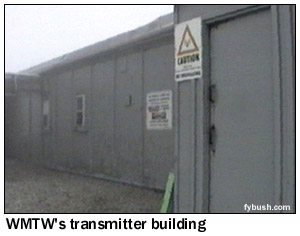 There are few spots as inhospitable
for a broadcast transmitter as the top of Mount Washington, New
Hampshire.
There are few spots as inhospitable
for a broadcast transmitter as the top of Mount Washington, New
Hampshire.
The highest point in the northeastern U.S. is renowned as the home of some of the worst weather in the world, including a record wind gust of 231 miles per hour and winter temperatures that routinely hover in the minus-twenties.
But at 6,288 feet above sea level, with a line of sight that stretches from Portland, Maine to Boston to southern Quebec, it was also an ideal spot to test the limits of VHF broadcasting in its earliest days.
In 1940, that meant FM radio - and in 1940, FM radio meant Edwin H. Armstrong, the inventor of the technology. Working with John Shepard, the owner of a Boston department store chain, Armstrong built the first FM network atop two New England peaks: Mount Asnebumskit in Paxton, near Worcester, Mass. and Mount Washington itself.
W1XER was the initial call for the station on Mount Washington's rocky crown, which actually began as a high-frequency AM station in 1937, operating on 42.3 megacycles. In the summer of 1940, Armstrong converted the station to FM operation, using the call W39B and the frequency of 43.9 mc when full-time operation began that December. The original antenna was made of eight truck springs, designed to bear the weight of the winter ice buildup on the mountain and spring back to shape once the ice melted in the spring!
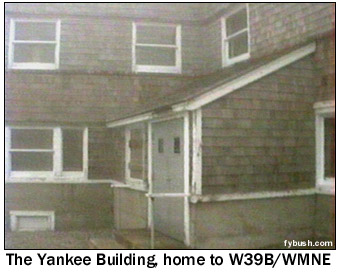
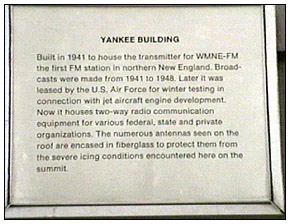 Two buildings atop
the mountain housed the station, which was officially licensed
to Boston, 150 miles distant.
Two buildings atop
the mountain housed the station, which was officially licensed
to Boston, 150 miles distant.
Shown at the left is the "Yankee Building" that housed the transmitter and studio facilities (though much of the programming originated at Yankee studios in Boston, relayed to the Asnebumskit transmitter and then picked up at Washington for rebroadcast); a short distance away is the Yankee powerhouse where the electricity needed for the broadcasts was generated. There has never been a power line running up the mountain from the valley below, and the broadcasters of Mount Washington have long borne the responsibility of providing power for the Mount Washington Observatory as well as their own needs.
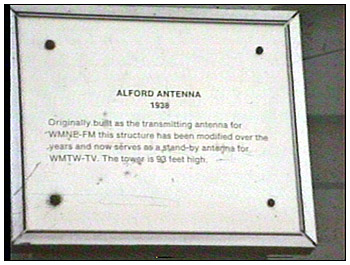
 W39B (known later
as WMTW-FM on 98.5 and still later as WMNE on 100.5, by then
licensed to Portland instead of Boston) used a 90-foot tower
next to the Yankee Building, with a series of antennas that started
with the famous "spring" antenna and were continually
modified as the station changed frequency over the years.
W39B (known later
as WMTW-FM on 98.5 and still later as WMNE on 100.5, by then
licensed to Portland instead of Boston) used a 90-foot tower
next to the Yankee Building, with a series of antennas that started
with the famous "spring" antenna and were continually
modified as the station changed frequency over the years.
The tower still stands, and we'll see it in a moment - but first, let's close a chapter in the mountain's history.
"The Rock" went silent on December 31, 1948, when the Yankee Network (by then owned by General Tire) decided the wide reach of the Mount Washington signal was outweighed by the very limited FM audience and the high cost of maintaining a year-round staff on a mountaintop that was inaccessible for days at a time in winter. (Then as now, engineers rotated on and off the mountain in one- or two-week shifts, getting up and down on snowmobiles.)
In the spring of 1954, Mount Washington became a busy place again; this time preparing for the arrival of television. A building and transmitter were fabricated in Manchester, then trucked north to be reassembled between the old Yankee Building and the powerhouse.
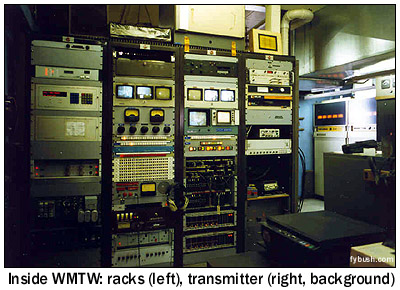
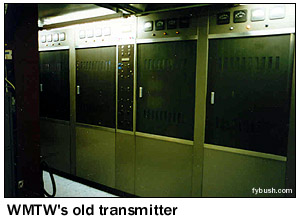 On
September 25, 1954, WMTW-TV, licensed to Poland Spring, Maine,
signed on from studios in the historic Riccar Inn and the new
105,000-watt transmission facility high atop Mount Washington.
On
September 25, 1954, WMTW-TV, licensed to Poland Spring, Maine,
signed on from studios in the historic Riccar Inn and the new
105,000-watt transmission facility high atop Mount Washington.
Programming was transmitted by microwave over the 46 miles between the two locations.
The signal from the Alford antenna atop the old Armstrong tower reached a huge swath of Maine, New Hampshire, Vermont, New York and Quebec - in many cases, areas that had never had a clear television signal until then.
In the sixties, WMTW upgraded its mountaintop facilities, building a new RCA antenna and tower completely enclosed in a cylindrical radome to replace the old Armstrong tower and Alford antenna, which remained available as a standby. In the seventies, a new RCA transmitter (just visible at rear in the above photo) supplanted the old TT-25 transmitter.
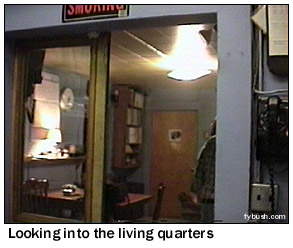 The
engineers who maintained the transmitter even became stars, in
a way; WMTW's newscasts featured live weather reports from the
mountaintop all winter long, delivered for many years by Marty
Angstrom, whose Maine accent became a hallmark of channel 8's
programming.
The
engineers who maintained the transmitter even became stars, in
a way; WMTW's newscasts featured live weather reports from the
mountaintop all winter long, delivered for many years by Marty
Angstrom, whose Maine accent became a hallmark of channel 8's
programming.
The transmitter building houses full living facilities, including two huge freezers to store a winter's worth of food, brought up each July and August to be eaten over the next ten months or so.
We were fortunate to meet Marty and the rest of the crew at WMTW when we visited The Rock in June of 1995 to take these pictures. It was a warm, sunny day as we approached the base of the Mount Washington Auto Road; by the time we reached the summit, it was in the forties and fog was rolling in.
By the time we left the transmitter building, the fog had surrounded the mountaintop, which is why you don't get to see as much of these towers as we'd hoped to present.
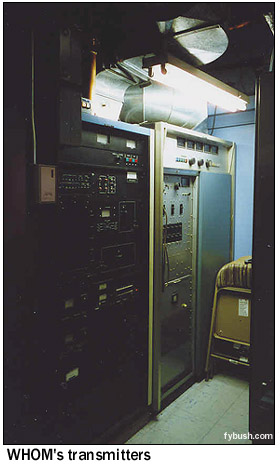
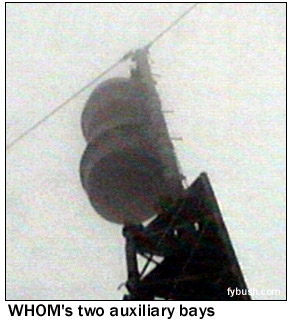 WMTW,
of course, was hardly alone on the mountaintop by the time we
got there.
WMTW,
of course, was hardly alone on the mountaintop by the time we
got there.
In 1958, WMTW added FM service to its TV facility, resurrecting the old WMTW-FM calls for a 48 kW facility on 94.9 MHz, licensed to "Mount Washington" itself.
Originally located on a two-bay antenna on a tower next to the TV transmitter building, WMTW-FM later moved to a new multi-bay antenna (completely enclosed in a cylindrical radome) alongside the power house. Sold off from the TV station in the seventies, 94.9 went through a few years as WMTQ before becoming WHOM, operating from studios in Portland and a transmitter (seen at left) in the WMTW-TV building, maintained all winter long by the channel 8 technicians.
A third station joined the crowd on the mountain in the eighties, when WMOU-FM (103.7 Berlin NH) moved from the WMOU (1230) tower down in the valley north of the mountain to a directional antenna on a tower near the Yankee building. (In fact, I believe the 103.7 antenna ended up, at least for a time, on the original Armstrong tower!).
WMOU-FM changed calls to WZPK, "the Peak," then to WPKQ, rebroadcasting the country music of WOKQ (97.5 Dover) down at the Seacoast, with advertising that targeted the North Conway region at the base of the mountain. Again, WMTW's engineers handled 103.7's engineering, while WMTW's generator provided the power for WPKQ's transmitter.
And so it went...until digital television came along and changed everything.
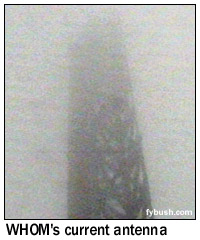
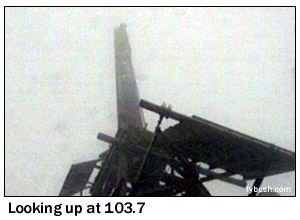 WMTW, assigned a
DTV allocation of channel 45, realized that a UHF signal from
Mount Washington would be unlikely to put a viewable DTV product
over Portland, its primary market.
WMTW, assigned a
DTV allocation of channel 45, realized that a UHF signal from
Mount Washington would be unlikely to put a viewable DTV product
over Portland, its primary market.
(The advent of cable and satellite television had cut significantly into WMTW's off-air viewership in the sparsely populated regions north and west of the mountain; by the eighties, channel 8 had moved its studio from Poland Spring to Auburn - and later to downtown Portland itself - and was solely focused on southern Maine.)
In 2001, WMTW built a new 1670-foot tower in the town of Baldwin, Maine, on the west side of Sebago Lake and just a few miles from the existing towers of Portland competitors WCSH-TV (Channel 6) and WGME (Channel 13), and on February 5, 2002, channel 8 signed off from the Mount Washington site and began transmitting from the state of Maine for the first time in its nearly half-century history. Soon, WMTW-DT will begin its own operations from the Baldwin tower. (Weather permitting, we hope to present this tower as next week's Site of the Week.)
What next for Mount Washington? There's pressure from Dartmouth University, which controls the mountaintop, to clear off some of the development that now greets hikers, drivers and those arriving on the historic Mount Washington Cog Railway. It's not clear who will provide power and maintenance for the radio stations and the Observatory in the absence of WMTW. And it's certain that Maine viewers won't hear Marty telling them about the nasty mountaintop weather any more.
Progress marches on, we suppose; certainly WMTW today is more interested in touting its "new, stronger signal" from Baldwin than in its long history atop Mount Washington. But we hope, years from now, that someone will still remember all the long winters and hard work that went into the transmission of television from this mountaintop.
(An addition, before we forget, to last week's Jamestown visit: We're told WKSN did indeed once have studios in the Fourth Street building that still houses its transmitter; the station was, in the sixties, owned by Lowell Paxson, who also owned channel 26 in its initial incarnation as an independent station. He, of course, went on to a long career owning radio stations in Florida, then the Home Shopping Network and now the Pax network!)
The More You Know...For much, much more detail on the early years of FM and TV on the Rock, don't miss the "Articles" section of Norm Gagnon's outstanding GGN Information Systems site. Norm also features several early photos of the FM installations on Mount Washington. Additional details on the Armstrong/Yankee years on the mountain provided by Granite and Ether: A Chronicle of New Hampshire Broadcasting by Ed Brouder (Bedford, N.H.: NH Association of Broadcasters, 1993).
- Previous Site of the Week: Jamestown, New York
- Next Week: TBA
- How can you help support Site of the Week? Click here!
- Submit your suggestions for a future Site of the Week!
